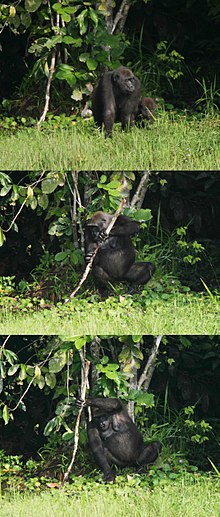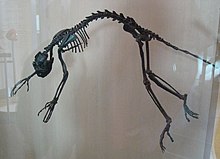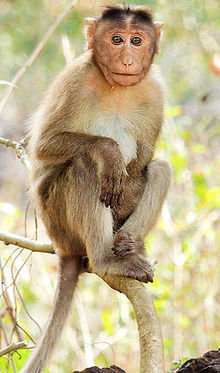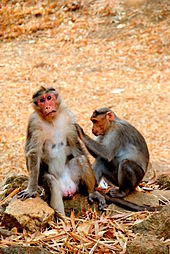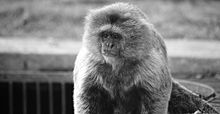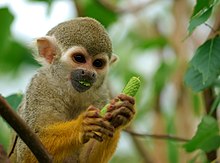From Wikipedia, the free encyclopedia
| Hominoids or Apes |
|
|---|---|
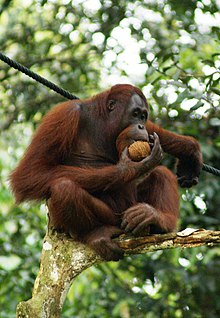 |
|
| Bornean orangutan (Pongo pygmaeus) | |
Scientific classification |
|
| Kingdom: | Animalia |
| Phylum: | Chordata |
| Class: | Mammalia |
| Order: | Primates |
| Suborder: | Haplorrhini |
| Infraorder: | Simiiformes |
| Parvorder: | Catarrhini |
| Superfamily: | Hominoidea Gray, 1825 |
| Type species | |
| Homo sapiens Linnaeus, 1758 |
|
| Families | |
| †Proconsulidae †Afropithecidae Hylobatidae Hominidae |
|
Apes (Hominoidea) are a branch of Old World tailless anthropoid catarrhine primates native to Africa and Southeast Asia and distinguished by a wide degree of freedom at the shoulder joint indicating the influence of brachiation. There are two main branches: the gibbons, or lesser apes; and the hominids or great apes.
- Lesser apes (Hylobatidae) include four genera and sixteen species of gibbon, including the lar gibbon, and the siamang, all native to Asia. They are highly arboreal and bipedal on the ground. They have lighter bodies and smaller social groups than great apes.
- The Hominidae include orangutans, gorillas, chimpanzees, bonobos and humans.[1][2] Alternatively, the family are collectively described as the great apes.[3][4][5][6] There are two extant species in the orangutan genus (Pongo), two species in the gorilla genus, and a single extant species Homo sapiens in the human genus (Homo). Chimpanzees and bonobos are closely related to each other and they represent the two species in the genus Pan.
Some or all hominoids are also called "apes". However, the term "ape" is used in several different senses. It has been used as a synonym for "monkey" or for any tailless primate with a humanlike appearance.[7] Thus the Barbary macaque, a kind of monkey, is popularly called the "Barbary ape" to indicate its lack of a tail. Biologists have used the term "ape" to mean a member of the superfamily Hominoidea other than humans,[3] or more recently to mean all members of the superfamily Hominoidea, so that "ape" becomes another word for "hominoid".[6][8] See also Primate: Historical and modern terminology.
Except for gorillas and humans, hominoids are agile climbers of trees. Their diet is best described as frugivorous and folivorous, consisting mainly of fruit, nuts, seeds, including grass seeds, and in some cases other animals,[9][10] either hunted or scavenged (or farmed solely in the case of humans), along with anything else available and easily digested.
Most non-human hominoids are rare or endangered. The chief threat to most of the endangered species is loss of tropical rainforest habitat, though some populations are further imperiled by hunting for bushmeat.
Historical and modern terminology
"Ape", from Old English apa, with cognates in several other Germanic languages, is a word of uncertain origin.[11] It is possibly an onomatopoetic imitation of animal chatter.[citation needed] The term has a history of rather imprecise usage. Its earliest meaning was that of any non-human primate, later often specialized to mean a tailless (and therefore exceptionally human-like) primate.[7][12] The original usage of "ape" in English might have referred to the baboon, an Old World monkey.[citation needed] Two tailless species of macaque have common names including "ape": the Barbary ape of North Africa (introduced into Gibraltar), Macaca sylvanus, and the Sulawesi black ape or Celebes crested macaque, M. nigra.As zoological knowledge developed, it became clear that taillessness occurred in a number of different and otherwise distantly related species. The term "ape" was then used in two different senses, as shown in the 1910 Encyclopædia Britannica entry. Either "ape" was still used for a tailless humanlike primate or it became a synonym for "monkey".[7]
Sir Wilfrid Le Gros Clark was one of the primatologists who developed the idea that there were "trends" in primate evolution and that the living members of the order could be arranged in a series, leading through "monkeys" and "apes" to humans. Within this tradition, "ape" refers to all the members of the superfamily Hominoidea, except humans.[3] Thus "apes" are a paraphyletic group, meaning that although all the species of apes descend from a common ancestor, the group does not include all the descendants of that ancestor, because humans are excluded.[13]
Greater and lesser
The diagram below shows the commonly accepted evolutionary relationships of the Hominoidea,[2] with the group traditionally called "apes" marked by a bracket.
|
apes
|
|
great apes
lesser apes
|
In recent years biologists have generally preferred to use only monophyletic groups in classifications;[15] that is, only groups which include all the descendants of a common ancestor.[16] The superfamily Hominoidea is one such group (or "clade"). Some then use the term "ape" to mean all the members of the superfamily Hominoidea. For example, in a 2005 book, Benton wrote "The apes, Hominoidea, today include the gibbons and orang-utan ... the gorilla and chimpanzee ... and humans".[6] The group traditionally called "apes" by biologists is then called the "non-human apes".
See the section History of hominoid taxonomy below for a discussion of changes in scientific classification and terminology.
Biology

The shoulder joints of hominoids, like the orangutan, are adapted to brachiation, or movement by swinging in tree branches.
The "lesser apes" are the gibbon family, Hylobatidae, with sixteen medium-sized species. Their major differentiating characteristic is their long arms, which they use to brachiate through the trees. As an evolutionary adaptation to this arboreal lifestyle, their wrists are ball and socket joints. The largest of the gibbons, the siamang, weighs up to 14 kg (31 lb). In comparison, the smallest "great ape" is the bonobo at 34 to 60 kg (75 to 132 lb).
The "great apes" were formerly treated as the family Pongidae. As noted above, this definition makes the Pongidae paraphyletic. Current evidence indicates that humans share a common extinct ancestor with the chimpanzee line, from which they separated more recently than the gorilla line.
The superfamily Hominoidea falls within Catarrhini, which also includes the Old World monkeys of Africa and Eurasia. Within this group, both families (Hylobatidae and Hominidae) can be distinguished from Old World monkeys by the number of cusps on their molars (hominoids have five—the "Y-5" molar pattern, Old World monkeys have only four in a bilophodont pattern). Hominoids have more mobile shoulder joints and arms due to the dorsal position of the scapula, broad ribcages that are flatter front-to-back, and a shorter, less mobile spine compared to Old World monkeys, with caudal (tail) vertebrae greatly reduced, resulting in complete tail loss in living species. These are all anatomical adaptations to vertical hanging and swinging locomotion (brachiation), as well as better balance in a bipedal pose. However, there are also primates in other families that lack tails, and at least one (the pig-tailed langur) that has been known to walk significant distances bipedally. The front skull is characterised by its sinuses, fusion of the frontal bone and post-orbital constriction.
Although the hominoid fossil record is far from complete, and the evidence is often fragmentary, there is enough to give a good outline of the evolutionary history of humans. The time of the split between humans and other living hominoids used to be thought to have occurred 15 to 20 million years ago. Some species occurring within that time period, such as Ramapithecus, used to be considered as hominins, and possible ancestors of humans. Later fossil finds indicated that Ramapithecus was more closely related to the orangutan, and new biochemical evidence indicated that the last common ancestor of humans and other hominins occurred between 5 and 10 million years ago, and probably in the lower end of that range.
Behaviour and cognition
Although there had been earlier studies, the scientific investigation of behaviour and cognition in non-human members of the superfamily Hominoidea expanded enormously during the latter half of the twentieth century. Major studies of behaviour in the field were completed on the three better-known "great apes", for example by Jane Goodall, Dian Fossey and Birute Galdikas. These studies have shown that in their natural environments, the non-human hominoids show sharply varying social structure: gibbons are monogamous, territorial pair-bonders, orangutans are solitary, gorillas live in small troops with a single adult male leader, while chimpanzees live in larger troops with bonobos exhibiting promiscuous sexual behaviour. Their diets also vary; gorillas are foliovores while the others are all primarily frugivores, although the common chimpanzee does some hunting for meat. Foraging behaviour is correspondingly variable.
All the non-human hominoids are generally thought of as highly intelligent, and scientific study has broadly confirmed that they perform outstandingly well on a wide range of cognitive tests – though there is relatively little data on gibbon cognition. The early studies by Wolfgang Köhler demonstrated exceptional problem-solving abilities in chimpanzees, which Köhler attributed to insight. The use of tools has been repeatedly demonstrated; more recently, the manufacture of tools has been documented, both in the wild and in laboratory tests. Imitation is much more easily demonstrated in "great apes" than in other primate species. Almost all the studies in animal language acquisition have been done with "great apes", and though there is continuing dispute as to whether they demonstrate real language abilities, there is no doubt that they involve significant feats of learning. Chimpanzees in different parts of Africa have developed tools that are used in food acquisition, demonstrating a form of animal culture.[17]
Distinction from monkeys
Apes do not possess a tail, unlike most monkeys. Monkeys are more likely to be in trees and use their tails for balance. Apes are considerably larger than monkeys, with the exception of gibbons, which are smaller than some monkeys. Apes are considered to be more intelligent than monkeys, which are considered to have more primitive brains.[18] Unlike female monkeys which go through the estrous cycle, great apes, including humans, go through a menstrual cycle.History of hominoid taxonomy
The history of hominoid taxonomy is somewhat confusing and complex. The names of subgroups have changed their meaning over time as new evidence, from fossil discoveries and comparisons of anatomy and DNA sequences, has changed understanding of the relationships between hominoids.There has been a gradual demotion of humans from a special position in the taxonomy to being one branch among many. This history illustrates the growing influence of cladistics (the science of classifying living things by strict descent) on taxonomy.
As of 2006, there are eight extant genera of hominoids. They are the four genera in the family Hominidae (Homo – humans, Pan – chimpanzees and bonobos, Gorilla, and Pongo – orangutans), and the four genera in the family Hylobatidae or gibbons (Hylobates, Hoolock, Nomascus and Symphalangus).[1] (The genus for the hoolock gibbons was recently changed from Bunopithecus to Hoolock.[19])
In 1758, Carolus Linnaeus, relying on second- or third-hand accounts, placed a second species in Homo along with H. sapiens: Homo troglodytes ("cave-dwelling man"). It is not clear to which animal this name refers, as Linnaeus had no specimen to refer to, hence no precise description. Linnaeus named the orangutan Simia satyrus ("satyr monkey"). He placed the three genera Homo, Simia and Lemur in the order of Primates.
The troglodytes name was used for the chimpanzee by Blumenbach in 1775 but moved to the genus Simia. The orangutan was moved to the genus Pongo in 1799 by Lacépède.
Linnaeus's inclusion of humans in the primates with monkeys and apes was troubling for people who denied a close relationship between humans and the rest of the animal kingdom. Linnaeus's Lutheran archbishop had accused him of "impiety." In a letter to Johann Georg Gmelin dated 25 February 1747, Linnaeus wrote:
- It is not pleasing to me that I must place humans among the primates, but man is intimately familiar with himself. Let's not quibble over words. It will be the same to me whatever name is applied. But I desperately seek from you and from the whole world a general difference between men and simians from the principles of Natural History. I certainly know of none. If only someone might tell me one! If I called man a simian or vice versa I would bring together all the theologians against me. Perhaps I ought to, in accordance with the law of Natural History.[20]
However, the many affinities between humans and other primates — and especially the "great apes" — made it clear that the distinction made no scientific sense. Charles Darwin wrote, in The Descent of Man:
- The greater number of naturalists who have taken into consideration the whole structure of man, including his mental faculties, have followed Blumenbach and Cuvier, and have placed man in a separate Order, under the title of the Bimana, and therefore on an equality with the orders of the Quadrumana, Carnivora, etc. Recently many of our best naturalists have recurred to the view first propounded by Linnaeus, so remarkable for his sagacity, and have placed man in the same Order with the Quadrumana, under the title of the Primates. The justice of this conclusion will be admitted: for in the first place, we must bear in mind the comparative insignificance for classification of the great development of the brain in man, and that the strongly marked differences between the skulls of man and the Quadrumana (lately insisted upon by Bischoff, Aeby, and others) apparently follow from their differently developed brains. In the second place, we must remember that nearly all the other and more important differences between man and the Quadrumana are manifestly adaptive in their nature, and relate chiefly to the erect position of man; such as the structure of his hand, foot, and pelvis, the curvature of his spine, and the position of his head.[21]
Changes in taxonomy
| Until about 1960, the hominoids were usually divided into two families: humans and their extinct relatives in Hominidae, all other hominoids in Pongidae.[22] | |
The 1960s saw the application of techniques from molecular biology to primate taxonomy. Goodman used his 1964 immunological study of serum proteins to propose a division of the hominoids into three families, with the "great apes" in Pongidae and the "lesser apes" (gibbons) in Hylobatidae.[23] The trichotomy of hominoid families, however, prompted scientists to ask which family speciated first from the common hominoid ancestor. |
|
Within the superfamily Hominoidea, gibbons are the outgroup: this means that the rest of the hominoids are more closely related to each other than any of them are to gibbons. This led to the placing of the "great apes" into the family Hominidae along with humans, by demoting the Pongidae to a subfamily; the Hominidae family now contained the subfamilies Homininae and Ponginae. Again, the three-way split in Ponginae led scientists to ask which of the three genera is least related to the others. |
|
Investigation showed orangutans to be the outgroup, but comparing humans to all three other hominid genera showed that African "apes" (chimpanzees and gorillas) and humans are more closely related to each other than any of them are to orangutans. This led to the placing of the African hominoids in the subfamily Homininae, forming another three-way split. This classification was first proposed by M. Goodman in 1974.[24] |
|
To try to resolve the hominine trichotomy, some authors proposed the division of the subfamily Homininae into the tribes Gorillini (African "apes") and Hominini (humans). |
|
However, DNA comparisons provide evidence that within the subfamily Homininae, gorillas are the outgroup. This suggests that chimpanzees should be in Hominini along with humans. This classification was first proposed (though one rank lower) by M. Goodman et al. in 1990.[2] See Human evolutionary genetics for more information on the speciation of humans and "great apes". |
|
| Later DNA comparisons split the gibbon genus Hylobates into four genera: Hylobates, Hoolock, Nomascus, and Symphalangus.[1][19] |
Classification and evolution[edit]
As discussed above, hominoid taxonomy has undergone several changes. Genetic analysis combined with fossil evidence indicates that hominoids diverged from the Old World monkeys about 25 million years ago, near the Oligocene-Miocene boundary.[25] The gibbons split from the rest about 18 mya, and the hominid splits happened 14 mya (Pongo), 7 mya (Gorilla), and 3-5 mya (Homo & Pan).[citation needed]The families, and extant genera and species of hominoids are:
- Superfamily Hominoidea[1]
- Family Hylobatidae: gibbons ("lesser apes")
- Genus Hylobates
- Lar gibbon or white-handed gibbon, H. lar
- Bornean white-bearded gibbon, H. albibarbis
- Agile gibbon or black-handed gibbon, H. agilis
- Müller's Bornean gibbon or grey gibbon, H. muelleri
- Silvery gibbon, H. moloch
- Pileated gibbon or capped gibbon, H. pileatus
- Kloss's gibbon or Mentawai gibbon or bilou, H. klossii
- Genus Hoolock
- Western hoolock gibbon, H. hoolock
- Eastern hoolock gibbon, H. leuconedys
- Genus Symphalangus
- Siamang, S. syndactylus
- Genus Nomascus
- Black crested gibbon, N. concolor
- Eastern black crested gibbon, N. nasutus
- Hainan black crested gibbon, N. hainanus
- Southern white-cheeked gibbon N. siki
- White-cheeked crested gibbon, N. leucogenys
- Yellow-cheeked gibbon, N. gabriellae
- Genus Hylobates
- Family Hominidae: hominids ("great apes")
- Genus Pongo: orangutans
- Bornean orangutan, P. pygmaeus
- Sumatran orangutan, P. abelii
- Genus Gorilla: gorillas
- Western gorilla, G. gorilla
- Eastern gorilla, G. beringei
- Genus Homo: humans
- Human, H. sapiens
- Genus Pan: chimpanzees
- Common chimpanzee, P. troglodytes
- Bonobo, P. paniscus
- Genus Pongo: orangutans
- Family Hylobatidae: gibbons ("lesser apes")
